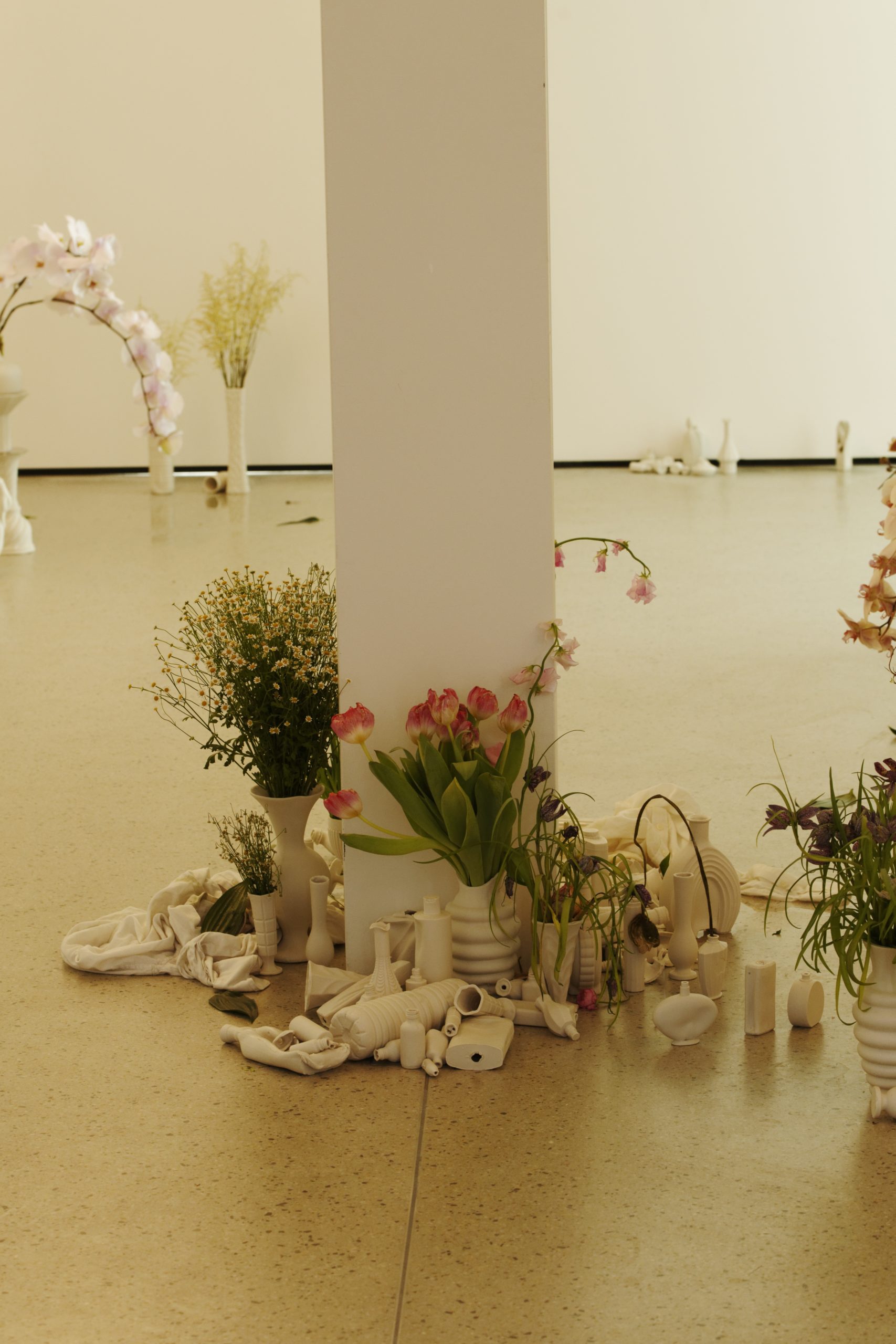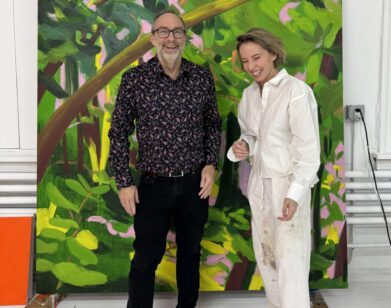art!
Bodies and Blooms Fill Morgan Courtois’ Theater of Decay

Photos courtesy Morgan Courtois.
Hundreds of fresh flowers fill Morgan Courtois’s solo exhibition, “Décharge,” at the Fondation Pernod Ricard. In the days before the opening, the 33-year old artist, along with the show’s esteemed curator Zoe Stillpass, took pre-dawn trips to Paris’s flower market to gather an eccentric array of blooms. On opening night, they appeared in Courtois’ unvarnished ceramic vessels—all based on various bottles, cans, and receptacles salvaged by the artist over the years for aesthetic or sentimental reasons. The gorgeous installation was reminiscent of a Dutch still life painting come to life (in fact, Courtois learned the craft of ceramic artists during a two-year residency in Amsterdam). However, as any reader of Romantic poetry knows, the flowers won’t last—a fact which excites Courtois tremendously. The flowers will wilt and shrivel during the entire run of the exhibition, filling the gallery with the potent odor of death and decay.
That isn’t the only smell that invades the first-floor halls of the Fondation. The French artist is also something of an expert in scents, and amid his collapsing ceramic swans and anatomical plaster sculptures, experimental odors emanate. In a sense, it smells like a city—or the memory of one—all the highs and lows, beauties and brutalities, wafting together to leave a distinct impression.
———
INTERVIEW: Your show is filled with the ghostly presence of bottles, receptacles, and containers all rendered in unvarnished porcelain. Where do these vessels come from and what do they mean to you?
MORGAN COURTOIS: They are like ghosts because they are connected to my memories. Many of these containers recall uncontained times and moments of excess. Over the years I’ve saved hundreds of vases and bottles of perfume, alcohol, poppers, laughing gas, holy water, shampoo, etc. Even the receptacles I found on the street are all related to some form of consumption. In that way, it’s like a landfill of memories. Some vases symbolize someone close to me; other bottles contain cheap liquor that made me black out, others I’ve used as vases. I am fascinated by their shapes, even when they’re not that beautiful. I relate them to fantasy somehow.

INTERVIEW: The flowers you’ve chosen for them are exquisite. I hear you had to wake up early to visit the Paris flower market?
COURTOIS: Zoe Stillpass came to pick me up at 4 am to go to Rungis! It’s the biggest market in Europe, with many different hangars for meat, fruit, vegetables, etc. But it’s where all the florists in Paris buy their flowers. Well, we did stop at a restaurant in the market for oysters and a glass of white wine at 9 am. There we were with our Sancerre and a gigantic cart filled with flowers. The rough-looking market workers on break were staring at us like we were lost birds. It ended up being a fabulous experience. I’ve always liked markets, and looking at vegetables and flowers is one of my main pleasures. I like their shapes and what they evoke. Closed lilies look like fruit, for example. They’re very desirable before they open but also so stubborn that they’re almost annoying. The show goes on as the flowers die and decay—hundreds of cut flowers that were fresh on the day of the opening. I have used a lot of tuberosa because they are aphrodisiac—nuns were not allowed to walk through fields of them because of their erotic smell. So the smell was very important in terms of their selection but I have also chosen some dyed flowers to evoke all the colors visible in the iridescence of a gasoline puddle. The colors coming from pollution are everywhere in the show.
INTERVIEW: Why is it meaningful to let the flowers wilt and die through the run of the show?
COURTOIS: Like carelessness, negligence, or disorder, there is beauty in the oblivion.
INTERVIEW: You’re a connoisseur of scents. How did your interest in smells as an art form begin? The art world is so visually minded.

COURTOIS: There is a smell in the show composed by different objects and processes like decomposition. The smell of a bouquet of dying flowers is so strong that I have displayed it next to a ready-made perfume called “Rêve d’or”. I like the concept of hiding a smell. I have tried to get rid of the smell of a decadent party by using this perfume to clean a sticky floor. From this memory I have made a simple perfume composed of “Reve d’or” and cigarettes that is sprayed every day during the show. Since 2010 I have been studying the composition of perfumes, and I’ve collaborated first with [famous “noses” like] Barnabé Fillon and Celine Barrel. And now I have my own perfume organ [a collection of scent flasks] where I use synthetic molecules, essential oils, DIY maceration, and some smells I made myself with my copper still. I also use a lot of cheap perfume and a lot of samples from luxury brands. I think it’s hard for the art world to be into something that goes in the air and that is meant to be consumed as quickly as a smell. A smell is related to a moment that’s not permanent, and I like to work in this vein of instability.
INTERVIEW: What’s your favorite smell?
COURTOIS: It changes everyday. Today I would love to smell a queen of the meadow (Filipendula ulmaria).

INTERVIEW: Your sculptures also revel in imperfections or less celebrated aspects of human anatomy.
COURTOIS: The sculptures for the show came out of two photo shoots I did. One is a detail of my boyfriend Jules’ hips. The other is a detail of Rahmat, a guy I met at a gay sauna in Amsterdam. I liked how his body was strong and fragile. He was lifting a lot of dumbbells I suppose. Most of the time I start by taking photographs and by enlarging them until they lose all proportion and become very abstract and pure. For this show, the plaster sculptures are all enlarged details of an erotic zone of the body. The sexual parts are at the edge of the sculpture.
INTERVIEW: Give us a scent recipe for love?
COURTOIS: The taste of the nicotine on his caffeine lips when I have tried to stop both.
INTERVIEW: For sex?
COURTOIS: Fenugrec with magnolia.
INTERVIEW: For violence?
COURTOIS: Spit on bloody roses in a stubborn gasoline slick.








